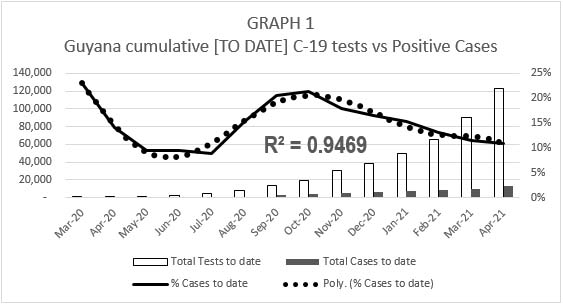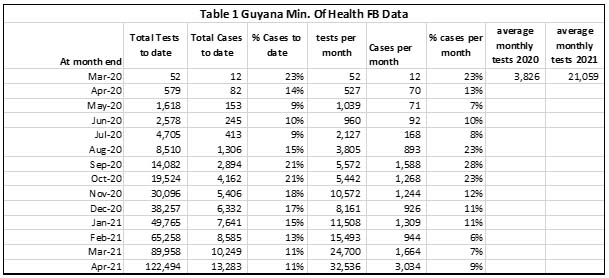Dear Editor,
First, it behooves me to profoundly thank, congratulate and encourage all directly involved in the fight against Covid-19 in Guyana. It has been and continues to be, a monumental task, often unappreciated; but I write you to draw your attention to some statistical misinformation ‘out there’ that could be affecting our national psyche. Please be assured, that I am in no way attempting to trivialize or even minimize the tremendous loss and suffering of those and their loved ones who have experienced this dreadful disease. As I write this, one of my friends struggles for his life in the ICU.
First, there is the impression that there has been a surge in the number of infections. The Ministry of Health certainly has been reporting an increasing number of cases. This may seem at first to indicate an upsurge in infections, but the actual data reveals that this is not the case.
Please allow me to submit data that I have extracted from the Facebook pages of the Ministry of Health (Covid-19 Dashboard) which show that the incidence of Covid-19 positive cases is in fact trending downwards. What has created the illusion that it is trending upwards, is the fact that the health authorities have been conducting an unprecedented number of tests, setting an all-time record of 32,500 tests in April 2021. This compares with the monthly average number of tests for 2020 of 3,826. The monthly average of tests for 2021 to the end of April was 21,059; a very meritorious effort (see Table 1).

(11%) by the end of March and April 2021. In Graph 1, the dotted line represents the trend of positive cases to tests, and it can be seen that it is trending downwards since the highs of around Aug -Oct. 2020. For the more statistically minded, the trendline is a sixth order polynomial trendline with an R-squared factor of 0.95. To the non-statistically-minded, this just is fancy math language to mean that
statistically, it is a very reliable trendline. This trend is evidently brought about by a general decline in the percentage of positive cases to tests per month.
Table 1 shows the monthly results of the tests conducted by the Min of Health (according to their FB page). Although the number of cases was very high in April, it represented ‘only’ 9% of those tested, up from 6% and 7% in February and April, but much better than practically the whole of 2020.

While our hearts go out to these countries, our fatality rate compares much better than the diaspora countries of the UK, 14th worse in the world at 1871/m, the USA 17th, 1777/m, and Canada, 639/m, 63rd. While there are likely other confounding variables, and while unnecessary travel should certainly be foregone, statistically, it looks better for folks over there to travel to Guyana than to eschew us. It’s an upward battle, but the data shows that we have been effective in the fight so far. I don’t have the full immunization data, as yet, but we seem to be well ahead ‘of the game’ in vaccinations as well. I should therefore like to congratulate and thank all our health workers and officials who risk their lives out there in the fight, and to wish them continued health and safety.
Sincerely,
Keith Evelyn




